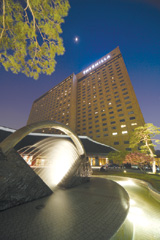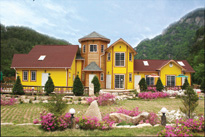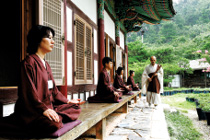
The Shilla Hotel in Seoul
Visitors to Korea can choose from a wide range of quality accommodations, including hotels, inns, hostels, homestays and condominiums.
Hotels: There is an extensive choice of hotels. An increasing number of hotels offer recreation facilities such as swimming pools, saunas, indoor driving ranges, bowling alleys and health clubs for their guests. There are also dance clubs, karaoke bars, casinos and recreation rooms, providing nighttime as well as daytime entertainment. In addition, exciting and fun-filled special seasonal events and packages are available throughout the year. To check out room availability and rates, please visit
http://www.korea.net/uesful_info/reservation/reservation_hotel.aspInns and hotels: Inns (yeogwan) and hostels are inexpensive types of accommodation. They offer simple, clean rooms. Rates vary with the services and facilities provided. Staying at hostels can cost as little as 10,000 won (single room)~160,000 won (family room) per night and inns range from 30,000 won to 60,000 won.
Condominiums: Condominiums are apartment-style lodgings which provide convenience and comfort because of their private cooking facilities and seminar rooms, swimming pools, recreational facilities and nearby restaurants and supermarkets. They are usually located near ski resorts, famous mountains, parks, and beaches and are quite spacious. Although condominiums are exclusively rented to members during peak seasons, they can be rented to nonmembers during the low season. The cost differs significantly according to facilities. There are luxury condominiums that can cost upwards of 200,000 per night.
 Pensions:
Pensions: Pensions are a new type of lodging that have recently appeared in Korea. Pensions are usually located in tourist areas filled with natural scenery and landscapes. They are European-style houses or cottages and provide an excellent place for rest and recreation in a natural setting. There are many forms of pensions from villas to simple log cabins. They are becoming extremely popular with couples and families.
Homestays: Some Korean families offer homestays at a very reasonable rate or even for free to make friends from other countries. This is a good opportunity to make Korean friends and experience Korean family life firsthand. To check out room availability and rates, please visit
http://www.korea.net/uesful_info/reservation/reservation_hotel.aspMinbak: In the countryside, some families rent rooms to travelers at very inexpensive rates, around 15,000 to 30,000 won depending on the season and the quality of the room. Since these "minbak" are often in humble private homes, the rooms do not come with private baths, and guests usually sleep and eat on the floor in the traditional Korean way. But a wholesome breakfast is often part of the arrangement, which is particularly nice if visiting small towns with no restaurants.
 Temple Stay:
Temple Stay: Modern life is fast paced and stressful. Living in a hectic world, we are always in a hurry to get to a place. Temple stay programs like the one at Samhwasa Temple give modern people a break from busy routines, an opportunity to concentrate on stillness and contemplation without all the accoutrements we carry throughout our urban lives.
Currently there are some 40 temples participating in the program nationwide. Basic overnight programs can be simplified to a half-day program (3.5 hours), or extended to 3- and 4-day experiences. Six temples are always open to individual participants while groups may make reservations at any temple all year long. Most temples participating in the program are located in well-preserved national or provincial parks. Thus, the program provides participants with a magnificent chance to relax, reflect and revitalize themselves in the tranquility of nature.
For more information about temple stay programs, go to
http://eng.templestay.com/.
· Homestay : http://www.homestaykorea.com/